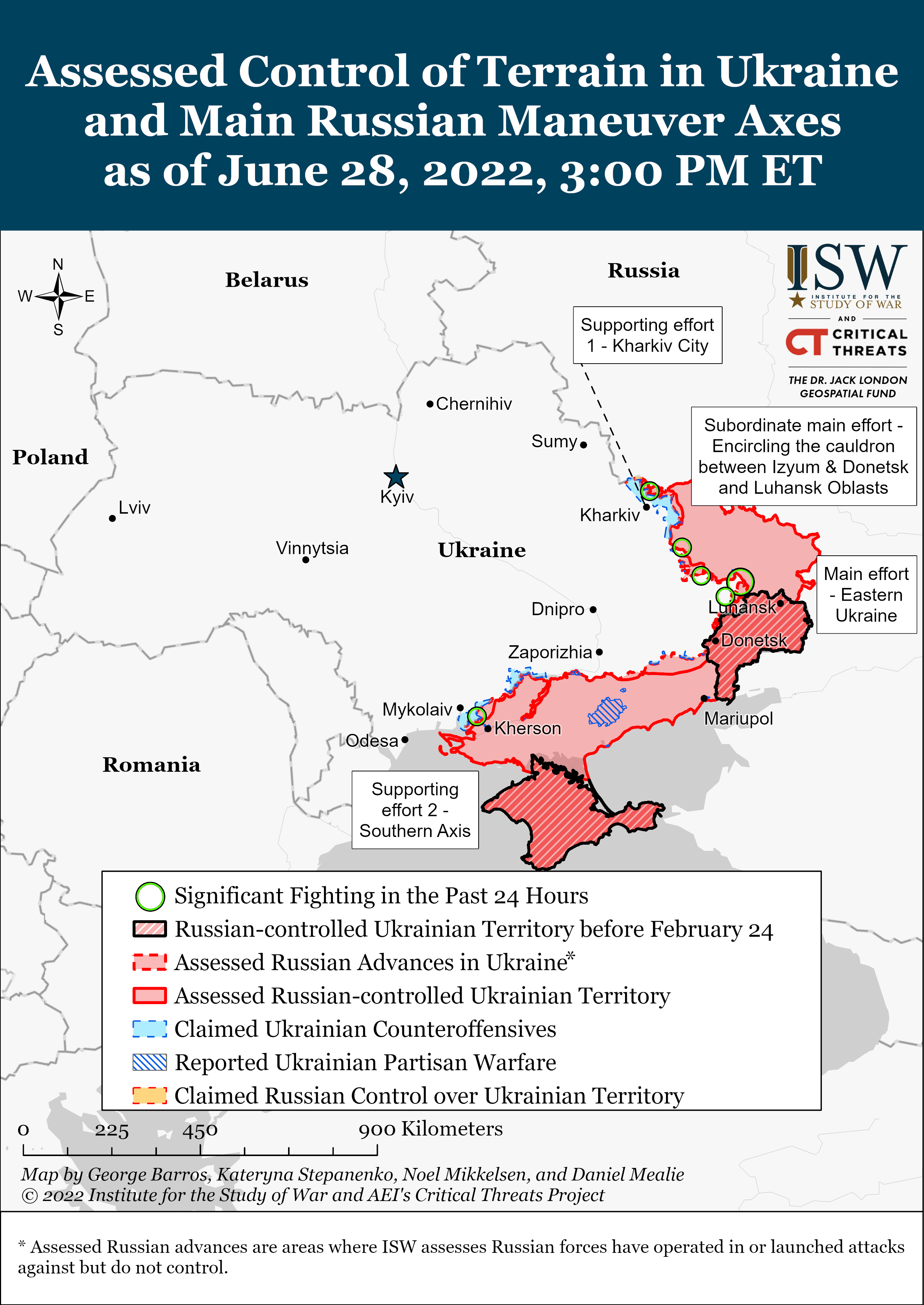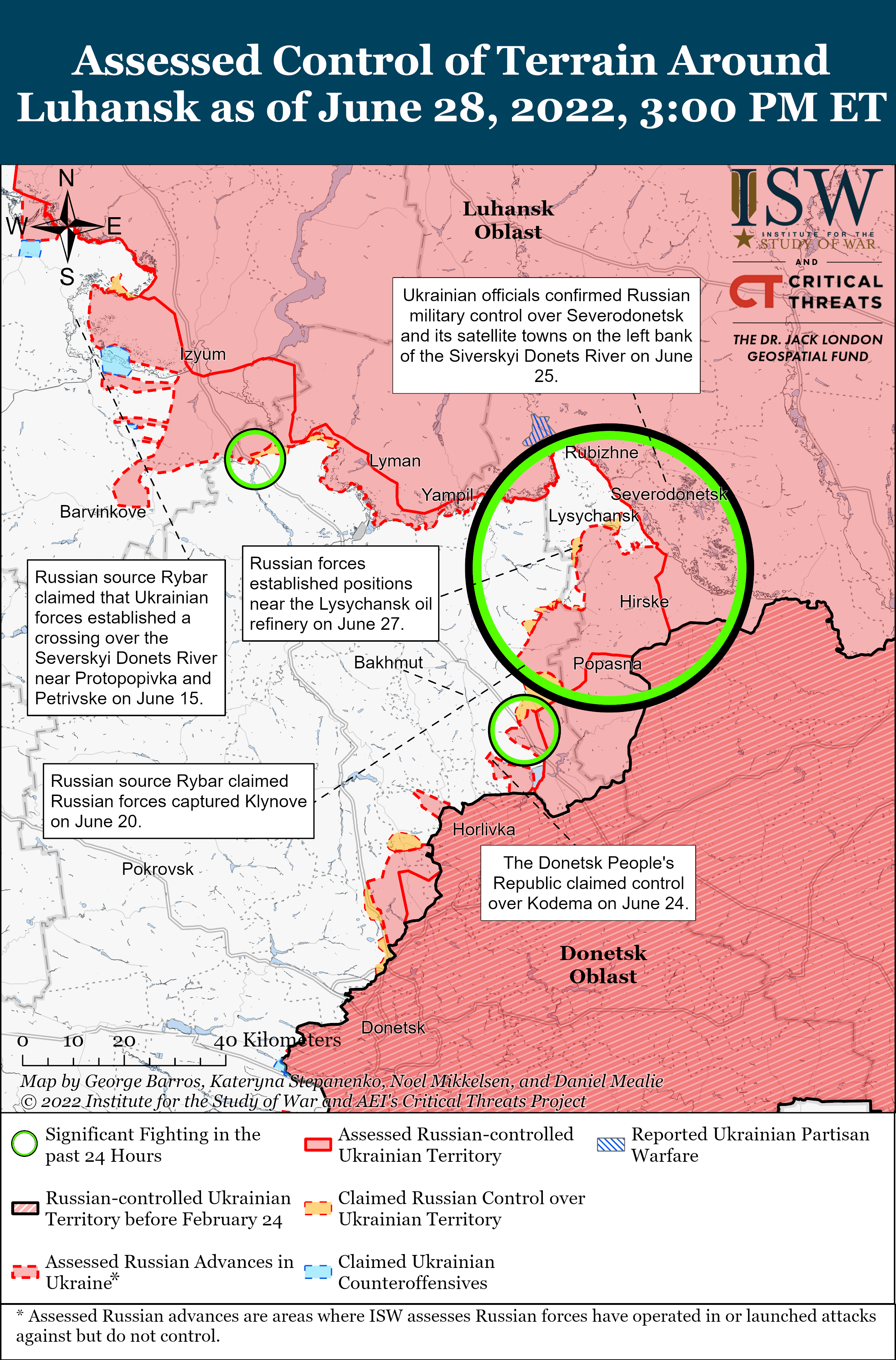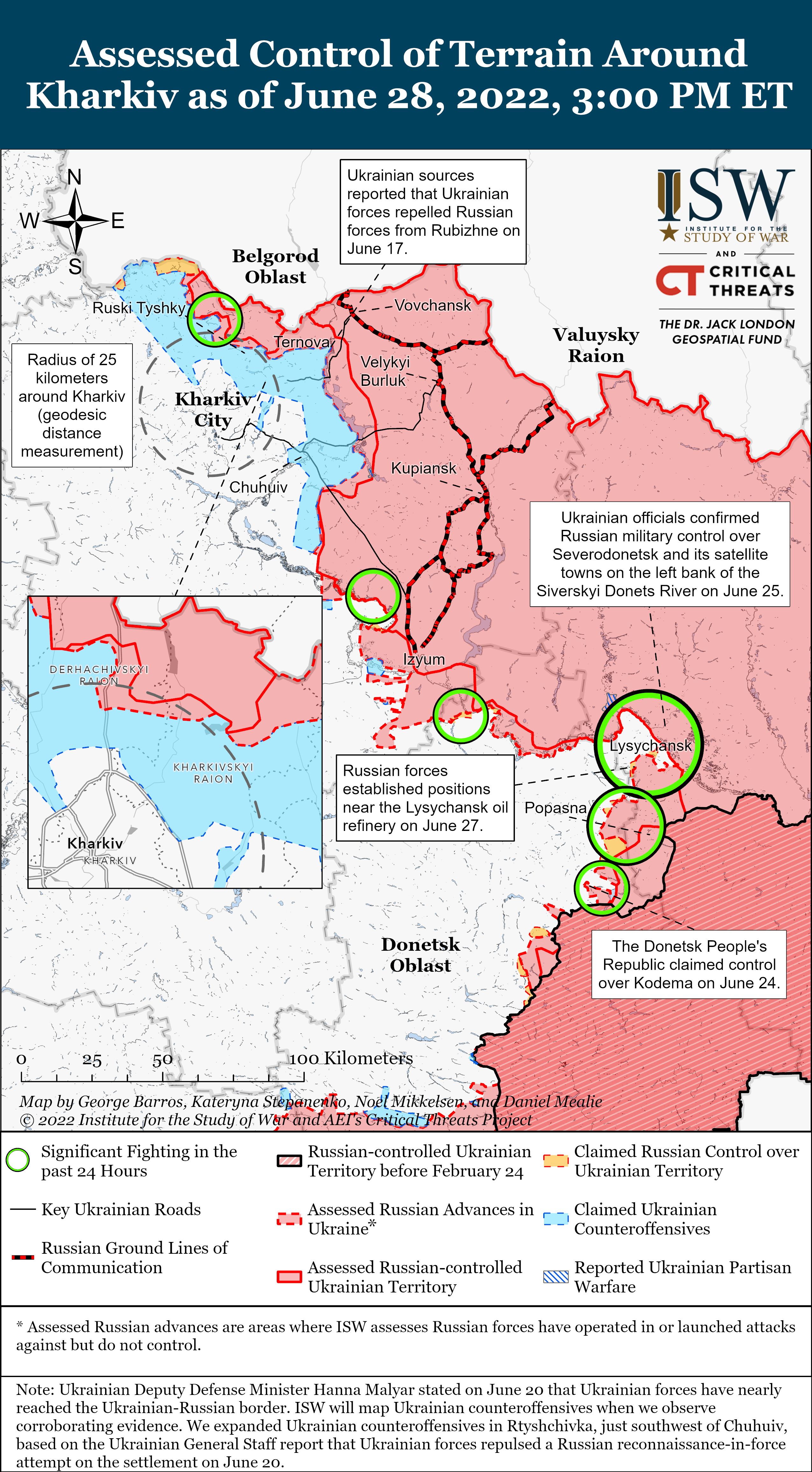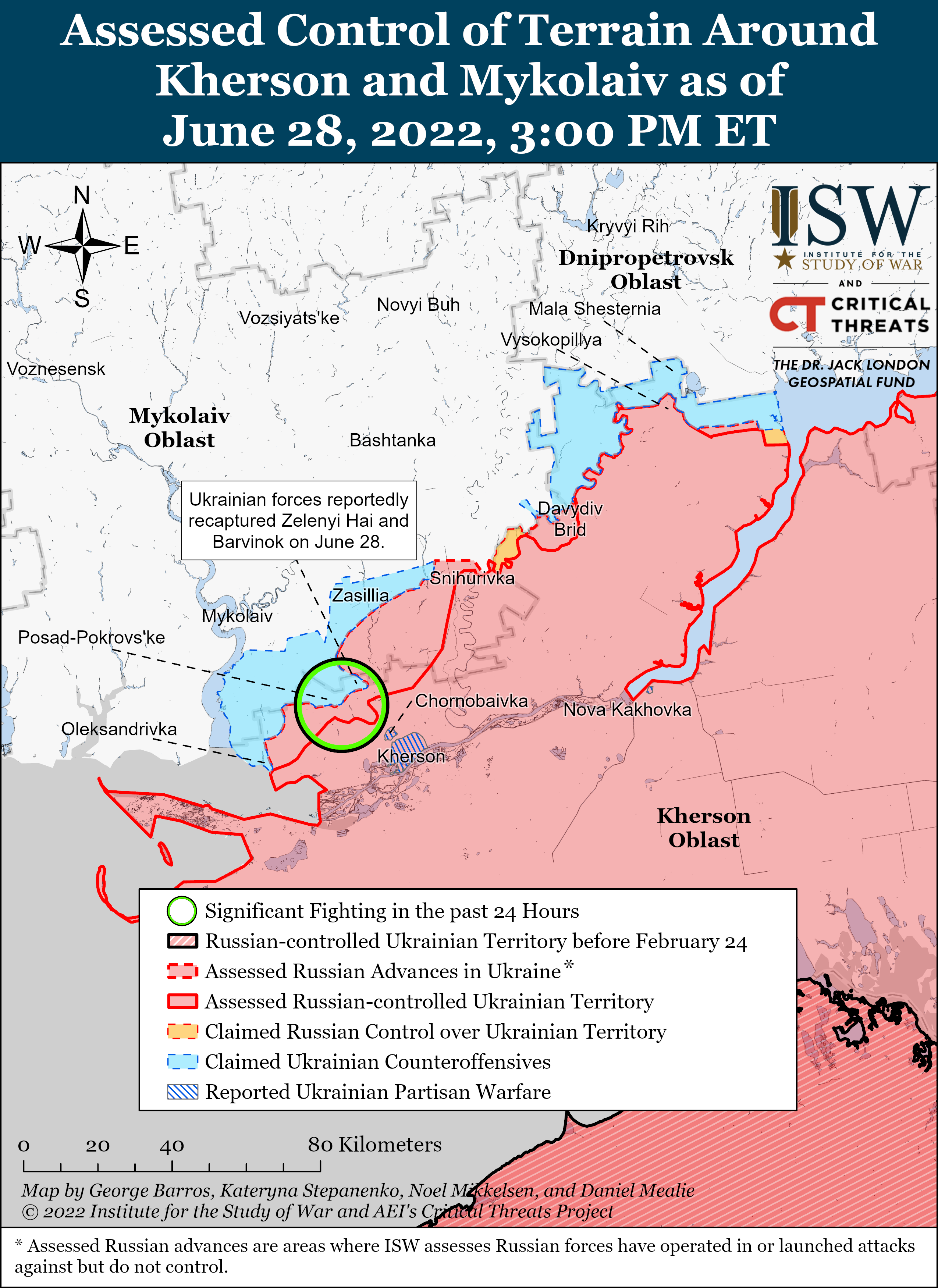ASSESSMENT
RUSSIAN OFFENSIVE CAMPAIGN , JUNE 28, 2022
Kateryna Stepanenko, Frederick W. Kagan, George Barros, Mason Clark, and Grace Mappes
June 28, 7:45 pm ET
Click here to see ISW's interactive map of the Russian invasion of Ukraine. This map is updated daily alongside the static maps present in this report.
Ukrainian forces are likely conducting a fighting withdrawal that may include pulling back from Lysychansk and Luhansk Oblast in the near future and which probably aims to force the Russian offensive to culminate prematurely. The Luhansk People’s Republic (LNR) Ambassador to Russia Rodion Miroshnik and Russian milbloggers claimed that Ukrainian forces began a large-scale withdrawal from Lysychansk towards Siversk, Kramatorsk, and Slovyansk on June 28.[1] Although ISW cannot confirm independently Miroshnik’s claims of an ongoing withdrawal, Ukrainian forces may continue the fighting withdrawal that began in Severodonetsk to Ukrainian strongholds around Siversk, Kramatorsk, and Slovyansk. The staunch but limited Ukrainian defense of Severodonetsk imposed high costs on the Russians despite new Russian tactics intended to limit Russian casualties. Kyiv could continue this approach until the Russian attack culminates or Ukrainian forces reach more defensible positions along a straighter line dotted with fortified cities and towns.
The pace and outcome of the next phase of the current campaign may depend in part on Russia’s ability to recoup combat power from the forces that participated in the Battle of Severodonetsk. The remaining Russian forces in Severodonetsk will need to cross the Siverskyi Donets River into Lysychansk from Severodonetsk or its surrounding settlements to participate further in the Russian offensive. This movement could require some time since the Russians destroyed the three main bridges across the river near the city. Miroshnik claimed that Russian forces have already crossed the Siverskyi Donets River from Kreminna and are building bridgeheads for further attacks on Lysychansk from the north.[2] ISW cannot independently verify Miroshnik’s claims. If they are true, and Russian forces threaten to complete the cauldron by pushing from the north and southwest of Lysychansk, then Ukrainian forces will likely abandon Lysychansk as well and conduct a fighting withdrawal to more defensible positions. Russian forces that have engaged in continuous offensive operations in Severodonetsk will also require some time to restore combat capabilities before participating in an assault on northern or northeastern Lysychansk. An unnamed Pentagon official stated that Russian forces continue to endure significant losses in fights for small territorial gains, and Russian groups that fought in Severodonetsk likely lost personnel and equipment.[3] The locations and strength of the Russian troops that seized Severodonetsk remain unclear at this time, however. A notable acceleration of Russian attacks from the south of Lysychansk or from across the Siverskyi Donetsk River would likely indicate that the Russians have completed a redeployment of forces from Severodonetsk. ISW has not yet observed such indicators.
Ukraine’s Conflict Intelligence Team (CIT) reported that the Kremlin replaced Western Military District (WMD) Commander Alexander Zhuravlev with the former commander of the 8th Combined Arms Army (CAA) Andrey Sychevoy.[4] CIT added that WMD Chief of Staff Aleksey Zavizion was relieved. ISW cannot independently verify these reports and will continue to monitor the situation for further corroboration.
Russian forces continue to look for additional reserves to replenish personnel losses in Ukraine, but these reserves are unlikely to initiate rotations or provide combat-ready manpower. Chechen leader Ramzan Kadyrov announced that he will form four new battalions “with an impressive number of personnel” on June 26.[5] Kadyrov also announced that Chechen forces formed a West-Akhmat battalion “in the shortest possible” time and claimed that the unit would deploy to a well-equipped base in Chechnya. Chechen forces will likely deploy the newly-created battalion to the frontline without sufficient training. Social media users also released footage of the Donetsk People’s Republic (DNR) rounding up “volunteers” in Donetsk City as part of the recruitment campaign on June 28.[6] Wives of servicemen of the Russian 5th Guards Separate Tank Brigade issued a video plea for the immediate rotation of their husbands back home, noting that their husbands had left their permanent bases of deployment in January 2022 for “exercises in Belarus.”[7] The video indicates that the Russian military command has expressed its intentions for unit rotations.
Key Takeaways
- Russian forces continued to launch assault operations south and southwest of Lysychansk. The Luhansk People’s Republic (LNR) officials claimed that Ukrainian forces had begun to withdraw from the city, but ISW cannot confirm these claims.
- Russian forces launched unsuccessful offensive operations north of Slovyansk and conducted spoiling attacks on settlements west of Izyum, likely to disrupt Ukrainian counteroffensives.
- Russian forces failed to advance along the Kharkiv City-Belgorod highway and continued to undertake measures to hinder Ukrainian advances towards the international border or Izyum.
- Ukrainian forces continued to launch counteroffensives north of Kherson City and reportedly liberated two settlements.
- Russian forces continued to transfer military equipment and personnel east of Melitopol.
- Russian occupation authorities are maintaining unsuccessful efforts to introduce ruble salary payments and set conditions to inflate electoral numbers in a future referendum.
We do not report in detail on Russian war crimes because those activities are well-covered in Western media and do not directly affect the military operations we are assessing and forecasting. We will continue to evaluate and report on the effects of these criminal activities on the Ukrainian military and population and specifically on combat in Ukrainian urban areas. We utterly condemn these Russian violations of the laws of armed conflict, Geneva Conventions, and humanity even though we do not describe them in these reports.
- Main Effort—Eastern Ukraine (comprised of one subordinate and three supporting efforts);
- Subordinate Main Effort—Encirclement of Ukrainian troops in the cauldron between Izyum and Donetsk and Luhansk oblasts
- Supporting Effort 1—Kharkiv City;
- Supporting Effort 2—Southern Axis;
- Activities in Russian-occupied Areas
Main Effort—Eastern Ukraine
Subordinate Main Effort—Southern Kharkiv, Donetsk, Luhansk Oblasts (Russian objective: Encircle Ukrainian forces in Eastern Ukraine and capture the entirety of Donetsk and Luhansk oblasts, the claimed territory of Russia’s proxies in Donbas)
Russian forces continued to conduct offensive operations southwest of Lysychansk to sever the T1302 Bakhmut-Lysychansk highway in several areas. Luhansk Oblast Administration Head Serhiy Haidai reported that Russian forces attempted to gain a foothold in the southern part of the Lysychansk Oil Refinery and pushed west of Vochoyarivka, but did not reach the T1302 as of June 28.[8] Haidai also added that Russian forces fought south and southwest of Lysychansk. Luhansk People’s Republic (LNR) Ambassador to Russia Rodion Miroshnik claimed that LNR and Russian forces have advanced a third of the way into Lysychansk from the south and are fighting at the Shaktar football stadium, while other troops cross the Siverskyi Donetsk River around Kreminna. ISW is unable to independently verify these claims.[9] The Ukrainian General Staff noted that Russian forces also conducted an unsuccessful attack west of Mykolaivka and Yakovlivka, both along the T1302.[10] Russian Su-25 aircraft struck Ukrainian positions in Bila Hora, just southeast of Lysychansk.[11]
Russian forces continued to make limited territorial gains south of Bakhmut on June 28. Russian forces continued to attack settlements along the E-40 highway that runs from Slovyansk to Bakhmut, approximately 13km southeast of Bakhmut.[12] The Ukrainian General Staff also added that Russian forces are attacking in the direction of the Uglehirska Power Plant northwest of Svitlodarsk.[13] Ukrainian forces reportedly repelled Russian attacks in Pavlivka, just east of the Donetsk-Zaporizhia Oblast border.[14]
Russian forces are likely continuing to launch spoiling attacks west of Izyum to disrupt Ukrainian counteroffensives in the area. The Ukrainian General Staff reported that Russian forces attempted an unsuccessful assault on Zalyman, approximately 26km northwest of Izyum, on June 28, having failed to advance in the area yesterday.[15] Russian forces likely continued to attack Zalyman with insufficient combat power to make real gains in their effort to disrupt Ukrainian counter-offensives and thereby defend Russian ground lines of communication (GLOCs) to Izyum through Borova (approximately 41km east). Ukrainian forces continued to target Russian equipment in Vesele, just east of Zalyman.[16] Russian forces are likely also continuing to conduct aerial reconnaissance and operate near Velyka Komyshuvakha (approximately 21km west of Izyum) to disrupt Ukrainian advances from the west.[17]
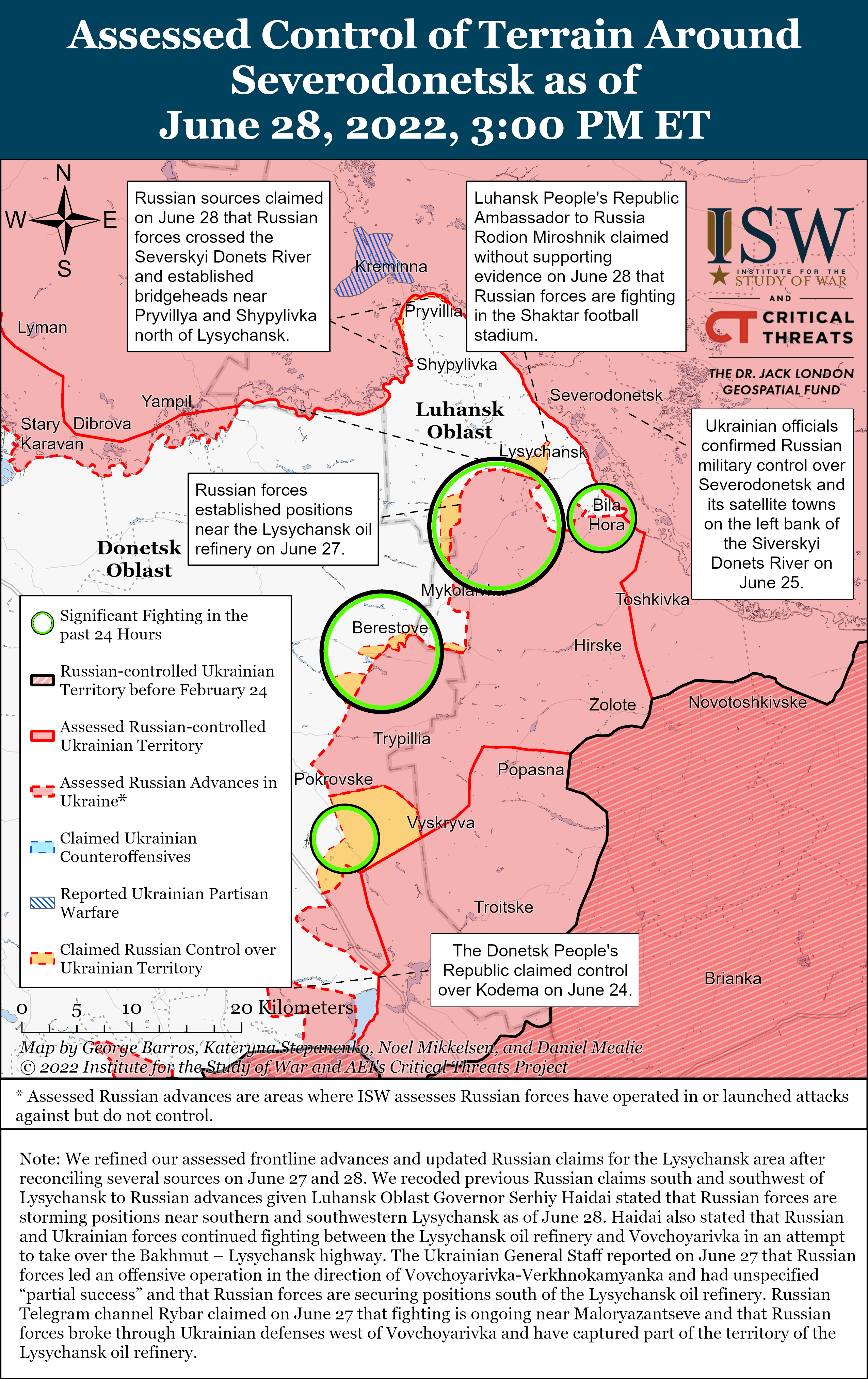
Russian forces conducted assaults north of Slovyansk but were unable to advance along the E-40 highway on June 28. Ukrainian Defense Ministry Spokesperson Oleksandr Motuzyanyk reported that Ukrainian forces repelled Russian offensive operations on Mazanivka, just west of the E40.[18] Russian forces also continued to shell settlements around Lyman and Slovyansk itself.[19]
Supporting Effort #1—Kharkiv City (Russian objective: Defend ground lines of communication (GLOCs) to Izyum and prevent Ukrainian forces from reaching the Russian border)
Russian forces launched unsuccessful offensive operations in northwestern Kharkiv Oblast and continued to undertake measures to prevent Ukrainian forces from reaching the international border or striking Russian positions southeast of Kharkiv City. Ukrainian Defense Ministry Spokesperson Oleksandr Motuzyanyk reported that Ukrainian forces repelled a Russian attack on Dementiivka along the Kharkiv City-Belgorod highway.[20] The Ukrainian General Staff added that Russian Ka-52 helicopters struck in the area of Yavirske, 65km southeast of Kharkiv City, likely to hinder Ukrainian counterattacks in the area.[21] Russian forces continued to shell Kharkiv City and settlements in its vicinity and conduct aerial reconnaissance.[22]
Supporting Effort #2—Southern Axis (Objective: Defend Kherson and Zaporizhia Oblasts against Ukrainian counterattacks)
Ukrainian forces continued to launch counteroffensive operations north of Kherson City on June 28. Ukrainian military journalist Andriy Tsaplienko reported that Ukrainian forces liberated Zelenyi Hai and Barvinok, approximately 25km north of Kherson City on the Mykolaiv-Kherson Oblast border.[23] An unnamed Pentagon official had previously reported that Ukrainian forces liberated small villages north and northwest of Kherson City over the weekend, but neither Ukrainian nor US officials had named these settlements as of June 28.[24] The Ukrainian Southern Operational Command stated that Russian forces unsuccessfully attempted to regain previously lost positions in Potyomkyne, Plotnytske, and Lupareve in northwestern Kherson Oblast.[25] Russian forces continued to shell and launch air strikes along the Mykolaiv-Kherson and Kherson-Dnipropetrovsk Oblast borders to disrupt Ukrainian counteroffensives.[26] Ukrainian Southern Operational Command Spokesperson Nataliya Gumenyuk noted that Ukrainian forces also struck three Russian Pantsir systems in a continuing effort to destroy Russian defenses on the Snake Island off the Romanian coast.[27]
Russian forces continued to transfer equipment and personnel east of Melitopol on June 28. Zaporizhia Oblast Military Administration Head Oleksandr Starukh reported that Russian forces are transporting military equipment to and from Melitopol to unspecified settlements in the east.[28] Starukh added that Russian forces moved a battalion tactical group (BTG) to Berdyansk and the Prymorsk area, but it is unclear if the BTG will continue further east or remain in that area. Russian forces may be relocating more military personnel to suppress rising partisan activity in cities like Berdyansk or could be reinforcing Russian defensive positions on the Donetsk-Zaporizhia Oblast border. Russian forces are also likely setting conditions to hold the E58 highway stretching from Rostov-on-Don to Kherson City even if Ukrainian counteroffensives push back the Russian line to the north.
Activity in Russian-occupied Areas (Russian objective: consolidate administrative control of occupied areas; set conditions for potential annexation into the Russian Federation or some other future political arrangement of Moscow’s choosing)
Russian occupation authorities continued to introduce bureaucratic measures to install societal control over occupied territories on June 28 but face challenges due to Ukrainian resistance. The Ukrainian Resistance Center reported that the Russian occupation administration is attempting to carry out a medical reform in Kherson Oblast to follow the Russian healthcare model.[29] Ukrainian healthcare workers largely refuse to cooperate with Russian occupation authorities, disrupting Russian plans to introduce ruble salaries in Kherson Oblast. The Ukrainian Southern Operational Command also noted that Russian forces are opening a network of offices in southern Ukraine offering Russian passports, likely to inflate electorate numbers before a referendum.[30]
[1] https://t.me/miroshnik_r/7782; https://t.me/strelkovii/2808; https://t.me/rybar/34573
[2] https://t.me/miroshnik_r/7781
[3] https://www.defense.gov/News/News-Stories/Article/Article/3075839/dod-of...
[4] https://twitter.com/CITeam_en/status/1541503442048393217
[5] https://t.me/RKadyrov_95/2444
[6] https://twitter.com/GirkinGirkin/status/1541729059406757888?s=20&t=zs9bi...
[7] https://t.me/m0sc0wcalling/7724
[8] https://t.me/luhanskaVTSA/3829?single; https://www dot ukrinform.ua/rubric-ato/3517127-vijska-rf-namagautsa-otociti-zsu-v-rajoni-lisicanska-minoboroni.html
[9] https://t.me/miroshnik_r/7781; https://t.me/rybar/34573
[10] https://www.facebook.com/GeneralStaff.ua/posts/349903877322697; https://www.facebook.com/GeneralStaff.ua/posts/349903877322697
[11] https://www dot ukrinform.ua/rubric-ato/3517127-vijska-rf-namagautsa-otociti-zsu-v-rajoni-lisicanska-minoboroni.html
[12] https://www dot ukrinform.ua/rubric-ato/3517127-vijska-rf-namagautsa-otociti-zsu-v-rajoni-lisicanska-minoboroni.html
[13] https://www.facebook.com/GeneralStaff.ua/posts/349903877322697
[14] https://www.facebook.com/GeneralStaff.ua/posts/349903877322697
[15]https://www.facebook.com/GeneralStaff.ua/posts/pfbid09KF3ZPHgiZqFf9FG94z...;
[16] https://twitter.com/Noobieshunta_/status/1541716205316218880
[17] https://twitter.com/antiputler_news/status/1541348686067896322; https://www dot ukrinform.ua/rubric-ato/3517115-zsu-na-harkivsini-vidkinuli-voroga-na-dvoh-napramkah.html; https://www dot ukrinform.ua/rubric-ato/3517127-vijska-rf-namagautsa-otociti-zsu-v-rajoni-lisicanska-minoboroni.html
[18] https://www dot ukrinform.ua/rubric-ato/3517115-zsu-na-harkivsini-vidkinuli-voroga-na-dvoh-napramkah.html
[19] https://www.facebook.com/GeneralStaff.ua/posts/pfbid09KF3ZPHgiZqFf9FG94z...; https://www.facebook.com/GeneralStaff.ua/posts/349903877322697
[20] https://www dot ukrinform.ua/rubric-ato/3517115-zsu-na-harkivsini-vidkinuli-voroga-na-dvoh-napramkah.html
[21] https://www.facebook.com/GeneralStaff.ua/posts/pfbid09KF3ZPHgiZqFf9FG94z...
[22] https://www.facebook.com/GeneralStaff.ua/posts/pfbid09KF3ZPHgiZqFf9FG94z...; https://t.me/synegubov/3504; https://t.me/synegubov/3505; https://t.me/synegubov/3510; https://twitter.com/StudMedia/status/1541444598517702657; https://www.facebook.com/Zadorenko/posts/pfbid02caPJu9oUP12c7z7ba8GuZNgS...
[23] https://t.me/Tsaplienko/10827
[24] https://www.defense.gov/News/News-Stories/Article/Article/3075839/dod-of...
[25] https://www.facebook.com/watch/?v=1107639849819527
[26] https://www.facebook.com/GeneralStaff.ua/posts/pfbid09KF3ZPHgiZqFf9FG94z...; https://www.facebook.com/GeneralStaff.ua/posts/349903877322697; https://t.me/rybar/34542; https://t.me/rybar/34537
[27] https://t.me/voenkorKotenok/37924; https://www.youtube.com/watch?v=lhs2JS_f9bI; https://tsn dot ua/ru/ato/ocherednoy-udar-vsu-po-ostrovu-zmeinyy-v-ok-yug-rasskazali-detali-o-rezultatah-voennoy-operacii-2097703.html
[28] https://t.me/zoda_gov_ua/9703
[29] https://sprotyv.mod.gov dot ua/2022/06/27/okupanty-ne-mozhut-znajty-kolaborantiv-sered-medykiv-na-hersonshhyni/
[30] https://www.facebook.com/okPivden/videos/1459994497781797/
